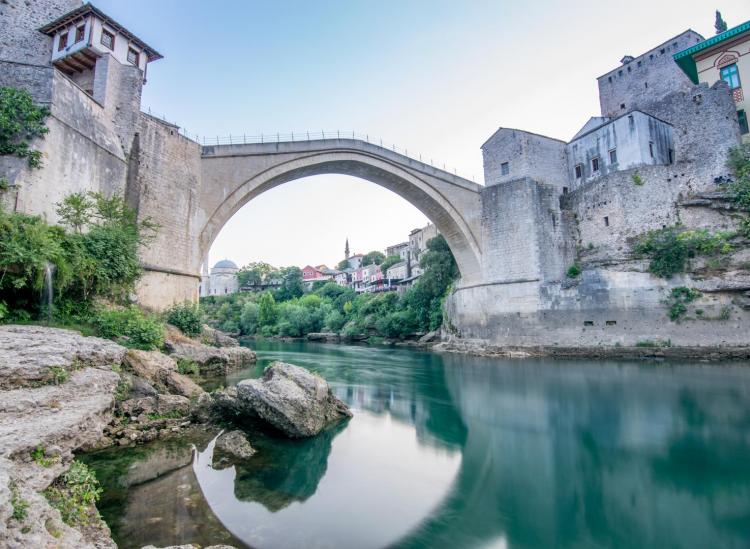Mostar’s Gorgeous Medieval Bridge Is Also An Insane Cliff-Diving Spot

Unsplash
The most common postcard-perfect photograph of Bosnia and Herzegovina is an arching limestone bridge over brilliant blue water. It’s seemingly serene, but it’s also the launching point for one of the country’s most daring adventure sports.
Mostar’s famed bridge basically feels like a combination of the drool-worthy scenery from “Game of Thrones” and a thrill-seeker’s fever dream. The Old Town is fantasy land kinds of gorgeous, and the actual bridge is a bucket list entry for cliff divers around the world.
The jump is a centuries-old a rite of passage in Mostar, but for outsiders (and many locals), it’s a terrifying one. The water is cold, it’s a long way down, and the current is strong. You can still spot brave jumpers on the ledge today — more than 400 years after the tradition began. Even Red Bull hosted a cliff diving world championship in Mostar. It’s a world-class kind of dive.
Technically, what happens in Mostar is bridge-diving, not cliff-diving. But the specifics of what it takes to make the leap make it almost more insane than jumping off a cliff.
The Dive
The Neretva River is 15 feet deep, and divers fall for three seconds at about 53 miles per hour, according to Vice. There’s a wrought-iron railing blocking easy access to a jumpable edge — and then the adrenaline seekers have to stare down the 80-foot drop into the water below.
But jump, they do. There’s a local diving club specializing in the feat, and the divers show off their best technique for visitors. Observers can donate some Bosnian Marks or Euros to the spectacle and wait for the tips to reach the diver’s quota — you know, what he deems worthy for catapulting off of the stone bridge.
If you’re dreaming of taking the plunge yourself, you better bring some serious cliff-diving expertise with you. The local diving club does allow non-native explorers to dive ($30) but only after some pretty intense training ($12). Again, this is not a jump to be taken lightly. Injuries are common and people have died in dives gone wrong.
The Tradition
Even knowing the danger, dozens of contestants dive every summer during the annual diving festival. The first diving contest occurred in 1556 just after the bridge was built. Over the centuries, Mostar divers developed special techniques for the three-second plummet into the Neretva, and champions showcase graceful swan dives into the icy water.
So how did people decide jumping from the towering bridge was the thing to do? The exact origins are unclear; the tradition did start 450 years ago, after all. But Mostar folklore considers the dive a rite of passage for local men. The jump proved courage — and clearly still does.
The diving club keeps track of every single jumper that’s successfully launched off the bridge since 2004. In August, they hit 2,500 — and Mostar’s popularity only continues to rise with backpackers and travelers looking beyond neighboring Croatia for an adventure.
The Bridge
Mostar’s current Stari Most, or Old Bridge, isn’t the actual medieval stonework. The original Ottoman bridge was destroyed in the Bosnian war (1992-95) and rebuilt 20 years later in exacting detail. On either side of the bridge, signs remind pedestrians walking across the beautiful and thrilling landmark, “Don’t forget.” Don’t forget the war, a complex ethnic and religious conflict that still impacts the country today.
But bridge-diving is one aspect of life that brings Mostar together (impressive in a city with neighborhoods, postal services, bus systems and schools divided along ethnic lines). Even during the war, locals dove from the bridge, AKA the front lines. Now, the divers are a top tourist driver, filling the bridge with visitors during the summer.
The new bridge is a UNESCO World Heritage Site that is “a symbol of reconciliation, international co-operation and of the coexistence of diverse cultural, ethnic and religious communities,” according to UNESCO. Everybody can jump, no matter their ethnicity, religion or origin. They just have to be brave enough to do it.











